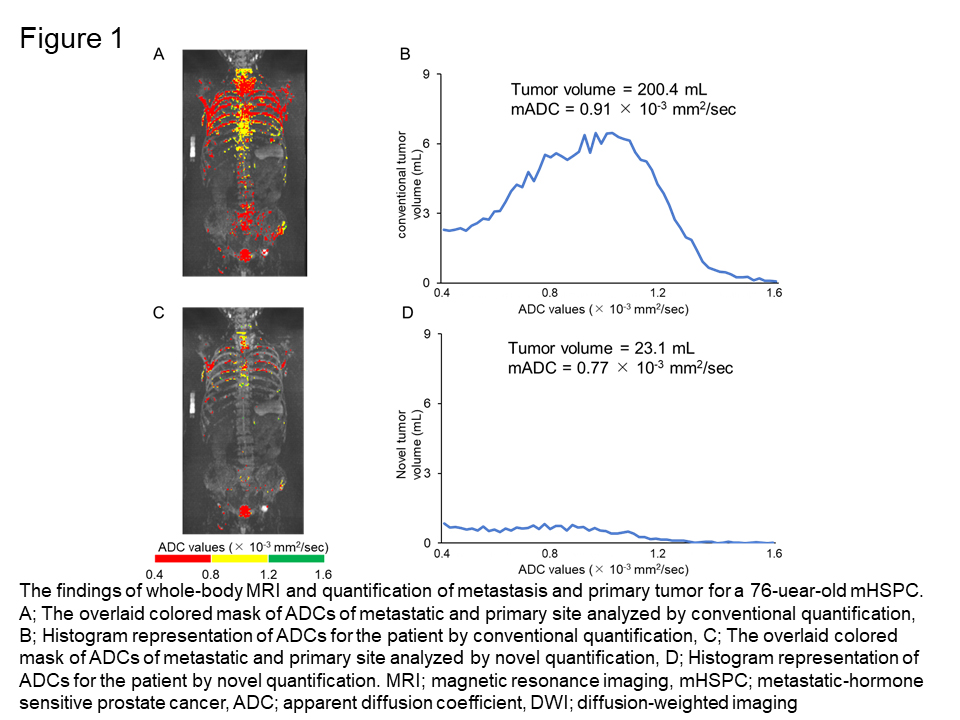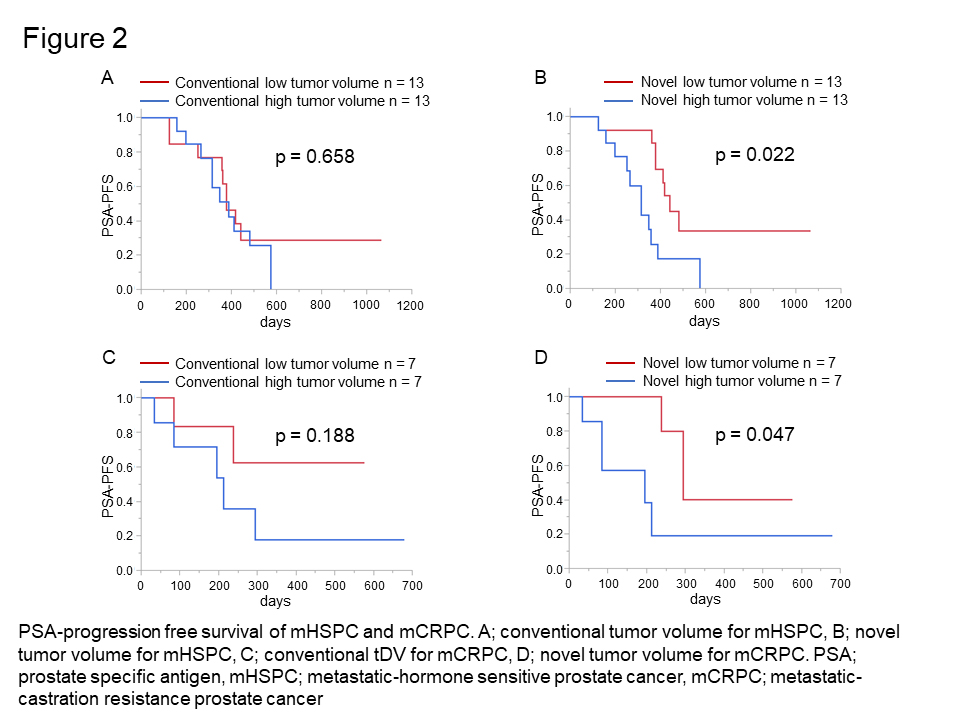Back
Poster, Podium & Video Sessions
Moderated Poster
MP51: Prostate Cancer: Staging
MP51-09: The Utility of Novel Quantification Using Imaging Software for Analyzing Whole-Body Magnetic Resonance Imaging of Patients with Metastatic Prostate Cancer
Sunday, May 15, 2022
4:30 PM – 5:45 PM
Location: Room 222
Yuki Kohada*, Nozomi Satani, Yasuhiro Kaiho, Sendai, Japan, Hiromichi Iwamura, Hirosaki, Japan, Takashi Kukimoto, Masaaki Oikawa, Jun Ito, Tomonori Matsuura, Sendai, Japan, Nobuyuki Hinata, Hiroshima, Japan, Kaneki Koyama, Makoto Sato, Sendai, Japan

Yuki Kohada
Tohoku Medical and Pharmaceutical University
Poster Presenter(s)
Introduction: We developed a novel quantification method that can automatically exclude the red bone marrow. This study assessed the utility of this novel method for accurately quantifying tumor volume (TV) and predicting the prognosis of patients with metastatic hormone sensitive prostate cancer (mHSPC) and metastatic castration resistance prostate cancer (mCRPC).
Methods: This was a prospective single-institution analysis of data acquired from patients diagnosed with mHSPC or mCRPC between 2017 and 2021. We developed a new function that automatically excluded the red bone marrow by analyzing whole-body diffusion-weighted imaging (DWI) and in-phase and opposed-phase T1-weighted imaging and integrated it into the original imaging software (Attractive BD_Score). The conventional quantification method estimates TV by analyzing whole-body DWI and does not exclude the red bone marrow. To assessed the prognostic value, prostate-specific antigen progression-free survival (PSA-PFS), time to pain progression (TPP), and overall survival were evaluated.
Results: Twenty-six patients with mHSPC and fourteen patients with mCRPC were included. A case that compares the novel and conventional quantification method is shown in Fig. 1. TV quantified using the novel quantification method was smaller than that by the conventional quantification in both mHSPC (median, 69.8 mL vs. 145.7 mL) and mCRPC (median, 38.7 mL vs. 56.9 mL). High TV, as measured using the new method, was significantly associated with poor PSA-PFS in patients with mHSPC (Fig. 2) and mCRPC and with poor TPP in patients with mHSPC (p < 0.05).
Conclusions: The novel quantification method could automatically exclude the red bone marrow, accurately quantify the TV, and help predict prognosis in patients with mHSPC and mCRPC.
Source of Funding: None


Methods: This was a prospective single-institution analysis of data acquired from patients diagnosed with mHSPC or mCRPC between 2017 and 2021. We developed a new function that automatically excluded the red bone marrow by analyzing whole-body diffusion-weighted imaging (DWI) and in-phase and opposed-phase T1-weighted imaging and integrated it into the original imaging software (Attractive BD_Score). The conventional quantification method estimates TV by analyzing whole-body DWI and does not exclude the red bone marrow. To assessed the prognostic value, prostate-specific antigen progression-free survival (PSA-PFS), time to pain progression (TPP), and overall survival were evaluated.
Results: Twenty-six patients with mHSPC and fourteen patients with mCRPC were included. A case that compares the novel and conventional quantification method is shown in Fig. 1. TV quantified using the novel quantification method was smaller than that by the conventional quantification in both mHSPC (median, 69.8 mL vs. 145.7 mL) and mCRPC (median, 38.7 mL vs. 56.9 mL). High TV, as measured using the new method, was significantly associated with poor PSA-PFS in patients with mHSPC (Fig. 2) and mCRPC and with poor TPP in patients with mHSPC (p < 0.05).
Conclusions: The novel quantification method could automatically exclude the red bone marrow, accurately quantify the TV, and help predict prognosis in patients with mHSPC and mCRPC.
Source of Funding: None



.jpg)
.jpg)